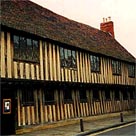Guildhall

Base layers
Data layers

Venue Type & Location
Site Name: Guildhall
Location: Stratford on Avon
County: Warwickshire
Location Type: Town - in town at determined location
Performance Spaces
Overview
The half-timbered Guildhall retains much of its late medieval character, with the late 15th c. stone Guild Chapel, early 15th c. almshouses and school buildings of various dates adjacent. The upper floor is jettied, with an overhang of approximately 2' on both sides of the building.
A detached, 15th c. 2-storey house, originally belonging to John Leeke, the donor of the Guildhall land, now forms the SE wing of the Guildhall.
The Guildhall is in the centre of town on Church Street near the junction with Chapel Lane. The Guild Chapel is situated at its N end and the almshouses at the S.
Performance History
Stratford chamberlains' accounts with payments to touring entertainers survive for the period 1567--1619. A 1602 civic ordinance that there should be no plays or interludes played in the guildhall or chamber indicates that both were used by such troupes.
All relevant dramatic records will be published in J. Alan B. Somerset's collection for Warwickshire in the REED series.
Current Status
The Guildhall remains in use by King Edward VI School and is open to the public at specified times during the year.
History of the Venue
1417 The half-timbered Guildhall was built by the Guild of the Holy Cross for varied purposes soon after its amalgamation with the guilds of St Mary and St John the Baptist.
1553 The hall was acquired by the newly incorporated borough in 1553 after the dissolution of the guild in 1547. The refounded King Edward VI School, originally in another building, was relocated to the upper room in the Guildhall before 1567, in which year alterations were carried out to the upper room, used by the school. The lower room was used by the Stratford corporation as the council chamber in the Elizabethan and Jacobean period.
Leeke's house became the Council Chamber of the corporation.
1702 Red brick vicarage built on the site of the former timber kitchen.
1786 Guildhall walls covered with stucco and ceilings lowered. Exterior staircase added on the east side leading to the upper floor.
1843 The hall ceased to be used by the corporation. The lower room was partitioned, with the room on the N end now used to store the town fire engine and the S end room used as a local drill hall. The upper room was also partitioned to form the Latin and Mathematics rooms.
By 1847, Corporation meetings in the old council chamber transferred to the new Town Hall.
1888 Stratford corporation gave the Guildhall and the Schoolhouse to the governors of the School.
1892--95 Restoration of the hall under the direction of the architect Arthur S. Flower. Stucco removed, original timber-framing revealed and repaired, windows refashioned. The partitions on both floors and the exterior staircase on the E side were removed. Removal of the boarding at the S end uncovered a window and 15th c. wall paintings concealed when the almshouses were joined to the Guildhall. Range extended to fill in the space between the Chapel tower and the N end of the hall. The N half-bay forms a passage through to the courtyard, with modern door leading into the hall and a porter's lodge in the extension.
1949 Plaster covering the walls of the upper room removed, revealing the half-timbering.
The upper room continued in use by the School from the 16th c. and is now known as Big School.
Record Source
REED Shakespeare Birthplace Trust Records Office: Chamberlains' Accounts, BRU 2/1 (1554--94), BRU 4/1 (1585--1619), BRU 4/12 (1590--7); Borough Book BRU 2/2 (1593--1628).
Bibliographic Sources
-
Fox, Levi. 'Some New Sidelights on Stratford-upon-Avon's Medieval Guild Buildings.' Transactions and Proceedings of the Birmingham Archaeological Society 70 (1954): 48–59.
-
Minutes and Accounts of Stratford upon Avon Corporation. Savage, Richard, ed. 2 vols. Oxford: Dugdale Society, 1921.
-
Page, William, ed. The Victoria History of the County of Warwick. The Victoria History of the Counties of England. 8 vols. London: Archibald Constable & Co. [vols 1-–2]; Oxford UP [vols 3-–8], 1904–8 [vols 1–2]; 1945–69 [vols 3–8].
-
Parker, Keith T. The Guild Chapel and other Guild Buildings of Stratford-upon-Avon. Stratford-upon-Avon: Stratford-upon-Avon Art Society & the Guild School Association, 1987.
-
Pevsner, Nikolaus, and Alexandra Wedgwood. Warwickshire. The Buildings of England. Harmondsworth, Midd: Penguin Books, 1966.
-
Richards, T.P. Guide to King Edward VI School and Chapel of the Guild of the Holy Cross. Stratford-upon-Avon: W. Stanton, nd [ca. 1910].




